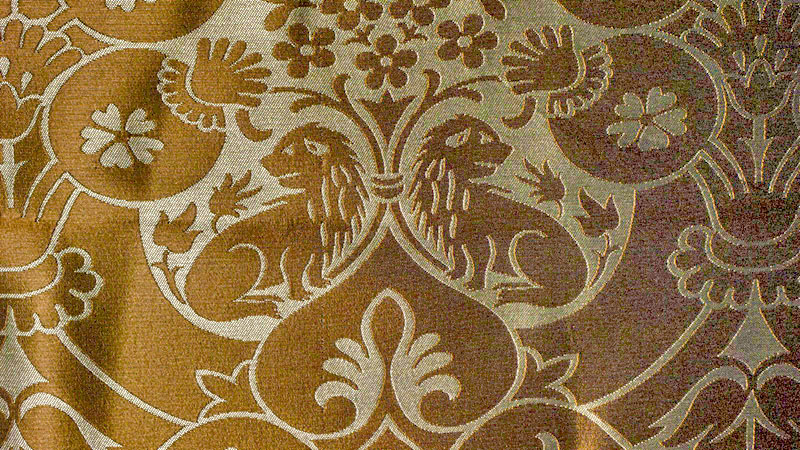This is one of the designs produced by the Hubert Gotzes weaving factory for ecclesiastical textiles established in Krefeld in1905. Here at the factory ecclesiastical vestments, that is to say priests’ robes, and other textiles for use in the church, were produced from precious silk cloth. The pattern repeat comprises two rows. In the first row there is a pair of male lions in a heart-shaped motif on the right-hand and left-hand side of a flower arrangement. The heads of the animals are turned away from each other. Between the motifs is a vase containing 5 pomegranates. In the second row there is a vase containing 3 carnation-type flowers above the pomegranates. On either side there is a bird with the body of a goose, although the feather headdress is more reminiscent of a peacock. Large tendrils bear five heart-shaped leaves which surround the area containing the birds. The models for this pattern are to be found in 15th century Italy. As it was not until the 19th century that textiles were woven specifically for liturgical use, silk cloth intended for secular use was used to make ecclesiastical vestments. Preference was given to patterns whose symbolism also had a sacral significance. For example, the lion, king of the animals, became the symbol for the power and glory of God. The lion was also the heraldic animal of the House of Judah (Genesis 49:9-10) and consequently of the Jewish kings since David, the ancestors of Jesus Christ. (Matthew 1,1-17). This product is made of pure filament silk. The design is based exclusively on traditional, historic patterns. A few years ago this pattern was still being manually woven on these premises on wooden Jacquard hand-looms which were up to two hundred years old. Please do not wash it by hand but have it professionally cleaned. Through your purchase you are not just acquiring a stylish pure silk item. You are also helping to preserve our gem for future generations. We wish you a great deal of pleasure with your scarf or tie.

